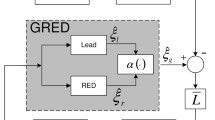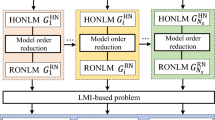Abstract
This paper presents the Lyapunov-based stability analysis of the Indirect Binary Model Reference Adaptive Controller (IB-MRAC) for relative-degree-one systems. The motivation for indirect adaptive control approaches relies on their capabilities of providing an easier and more intuitive controller design. IB-MRAC is a mixed controller, acting as an Indirect MRAC or as an Indirect Variable Structure MRAC depending on a design parameter. The main result herein described states that the overall system error tends exponentially fast to some small residual set.


Similar content being viewed by others
References
Astrom, K. J., & Wittenmark, B. (1989). Adaptive control. Massachusetts, USA: Addison-Wesley.
Azza, H. B., Zaidi, N., Jemli, M., & Boussak, M. (2014). Development and experimental evaluation of a sensorless speed control of SPIM using adaptive sliding mode-MRAS strategy. IEEE Journal of Emerging and Selected Topics in Power Electronics, 2(2), 319–328.
Barambones, O., Alkorta, P., & Durana, J. M. G. (2014). Adaptive sliding mode position control for electrical motors, Proceedings of the 2014 International Conference on Computational Science and Computational Intelligence (pp. 17–23).
Costa, R. R., & Hsu, L. (1991). Unmodeled dynamics in adaptive control systems revisited. System and Control Letters, 16, 341–348.
Dias, S., Queiroz, K., & Araujo, A. (2014). Robust control applied to multiple-input multiple-output nonlinear systems. Journal of Control, Automation and Electrical Systems, 25(6), 668–678.
Emelyanov, S. V. (1987). Binary automatic control systems. Moscow: MIR Publishers. (English Translation).
Estrada, A., Plestan, F., & Allouche, B. (2013). An adaptive version of a second order sliding mode output feedback controller, Proceedings of the 2013 European Control Conference (pp. 3228–3233).
Hsu, L. (1990). Variable structure model reference adaptive control using only input and output measurements: the general case. IEEE Transactions on Automatic Control, AC–35(11), 1238–1243.
Hsu, L., & Costa, R. R. (1989). Variable structure model reference adaptive control using only input and output measurements—part I. International Journal of Control, 49(2), 339–416.
Hsu, L., & Costa, R. R. (1990). A binary control approach to design globally exponentially stable adaptive systems, Proceedings of the 7th International Conference on Systems Engineering, Las Vegas.
Hsu, L., & Costa, R. R. (1994). B-MRAC: Global exponential stability with a new model reference adaptive controller based on binary control theory. Control-Theory and Advanced Technology, 10(4), 649–668. Part 1.
Ioannou, P. A., & Kokotovic, P. V. (1984). Instability analysis and improvement of robustness of adaptive control. IEEE Transactions on Automatic Control, 20(5), 583–594.
Ioannou, P. A., & Sun, J. (1996). Robust adaptive control. New Jersey: Prentice Hall.
Ioannou, P. A., & Tsakalis, K. S. (1986). A robust direct adaptive controller. IEEE Transactions on Automatic Control, 31(11), 1033–1043.
Lakhekar, G. V., & Saundarmal, V. D. (2013). Novel adaptive fuzzy sliding mode controller for depth control of an underwater vehicles, Proceedings of the 2013 IEEE International Conference on Fuzzy Systems (pp. 1–7).
Naik, S. M., Kumar, P. R., & Ydstie, B. E. (1992). Robust continuous-time adaptive control by parameter projection. IEEE Transactions on Automatic Control, 37, 182–197.
Narendra, K. S., Lin, Y. H., & Valavani, L. S. (1980). Stable adaptive controller design–direct control. IEEE Transactions on Automatic Control, AC–25(6), 570–583.
Oliveira, J. B., & Araujo, A. D. (2008). Design and stability analysis of an indirect variable structure model reference adaptive control. International Journal of Control, 81(12), 1870–1877.
Oliveira, J. B., Araujo, A. D., & Dias, S. M. (2010). Controlling the speed of a three-phase induction motor using a simplified indirect adaptive sliding mode scheme. Control Engineering Practice, 18(6), 577–584.
Oliveira, T. R., Peixoto, A. J., Nunes, E. V. L., & Hsu, L. (2012). Binary robust adaptive control for global tracking of uncertain systems with unknown high-frequency-gain sign, Proceedings of the 12th IEEE Workshop on Variable Structure Systems - VSS’12 (pp. 124–129).
Pereira, A. R., Hsu, L., & Ortega, R. (2009). Globally stable adaptive formation control of Euler–Lagrange agents via potential functions, Proceedings of the 2009 American Control Conference (pp. 2606–2611).
Rohrs, C. E., Valavani, L., Athans, M., & Stein, G. (1985). Robustness of continuous-time adaptive control algorithms in the presence of unmodeled dynamics. IEEE Transactions on Automatic Control, AC–30(9), 881–889.
Slotine, J. J. E., & Li, W. (1991). Applied nonlinear control. New Jersey, USA: Prentice Haw.
Sugiki, A., Furuta, K., Ohata, A., & Nita, H. (2014). Nonlinear variable structure adaptive control, Proceedings of the 2014 American Control Conference (pp. 1298–1303).
Teixeira, L. R. L., Oliveira, J. B., & Araujo, A. D. (2011) Indirect binary model reference adaptive control, Proceedings of the 9th IEEE International Conference on Control and Automation (pp. 877–882).
Tuan, D. M., Man, Z., Zhang, C., & Zheng, J. (2013). Sliding mode learning control for nonminimum phase nonlinear systems, Proceedings of the 8th IEEE Conference on Industrial Electronics and Applications (pp. 1290–1295).
Yanque, I., Nunes, E. V. L., Costa, R. R., & Hsu, L. (2012). Binary MIMO MRAC using a passifying multiplier—A smooth transition to sliding mode control, Proceedings of the 2012 American Control Conference (pp. 1925–1930).
Author information
Authors and Affiliations
Corresponding author
Appendices
Appendix A
From (19) and knowing that \( {\hat{\theta }_{p}}^T = \left[ \begin{array}{cccc} \hat{k}_{p}&\hat{\beta }^{T}&\hat{\alpha }_{1}&\hat{\alpha }^{T} \end{array} \right] \), one has:
Deriving (40), we obtain:
Replacing \(\dot{\hat{\theta }}_{p}\) by IB-MRAC adaptive laws (16), one has:
Performing some simplifications, we obtain the following equation for \(\dot{V}\):
Developing (43), one has:
From (18), and knowing that \(\hat{\beta }^{T}\hat{\beta } = {||\hat{\beta }||}^2\) and \(\hat{\alpha }^{T}\hat{\alpha } = {||\hat{\alpha }||}^2\), one has:
Appendix B
Calculating the derivative of (21), one has:
Knowing that \(k_{p}\) is a constant, one has that \({\tilde{\beta }}^{T}\varGamma _{\beta }^{-1}\tilde{\beta } \dot{k}_{p} = 0\). Performing some cancellations and replacing \(\dot{e}\) by (13), we obtain:
Reorganizing (47), one has:
Considering the Kalman–Yakubovich Lemma (\(A_{c}^{T}P + PA_{c} = -2Q, Pb_{c} = h_{c}, P = P^{T} > 0, Q = Q^{T} > 0\)), one has that \(e^{T}Pb_{c} = e^{T}h_{c} = h_{c}^{T}e = e_{o}\). Applying the changes in (48):
From (12), we can observe that \(\tilde{\theta }_{p} = \hat{\theta }_{p} - \theta _{p}\), and, consequently, \(\dot{\tilde{\theta }}_{p} = \dot{\hat{\theta }}{p} - \dot{\theta }_{p}\). As \(\theta _{p}\) is a constant vector, \(\dot{\theta }_{p} = 0\) and, thus, \(\dot{\tilde{\theta }}_{p} = \dot{\hat{\theta }}_{p}\). Therefore, (49) can be replaced by:
Replacing \(\dot{\hat{\theta }}_{p}\) by (16), one has:
Rights and permissions
About this article
Cite this article
Teixeira, L., Oliveira, J.B. & Araujo, A.D. Stability Analysis of Indirect Binary Model Reference Adaptive Controller for Plants with Relative Degree One. J Control Autom Electr Syst 26, 337–347 (2015). https://doi.org/10.1007/s40313-015-0185-3
Received:
Revised:
Accepted:
Published:
Issue Date:
DOI: https://doi.org/10.1007/s40313-015-0185-3




